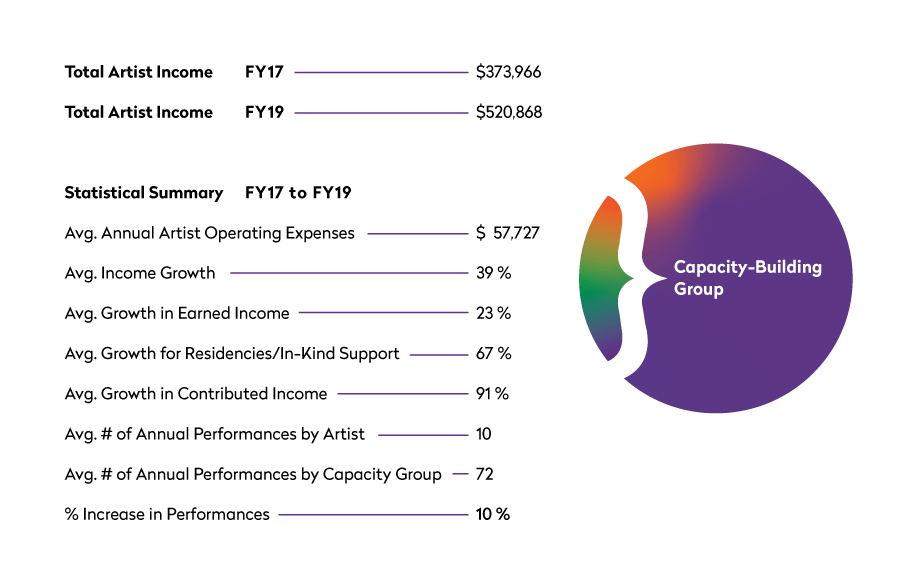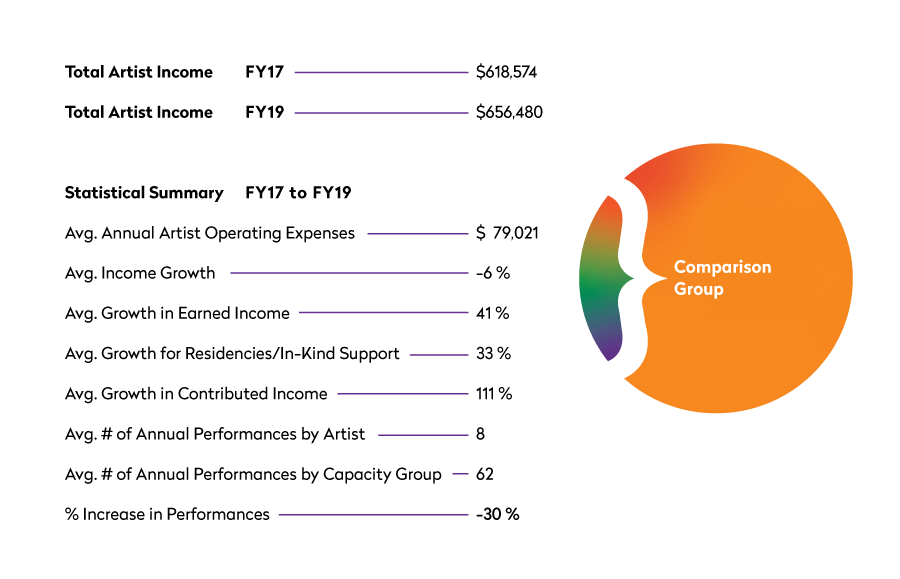ART Program Impact
November 2017 – June 2019
To determine the outcomes from the inputs of ART’s focused administrative support, Arts and Cultural Strategies conducted the following activities between November 2017 and June 2019:
- Reviewed quarterly mentor progress reports,
- Documented the evolving relationships among the teams of artists, mentors and administrators, and changes in ART administrative procedures,
- Attended final assessment meetings with artists in both cohorts with the same team of external assessment consultants (repeat of the 2016 procedure),
- Conducted exit research interviews with all artists about their participation in ART, and
- Interviewed all artists (n=16) to document their personal reflections about the current health of the dance field in important areas of funding, performance and residency opportunities, trends in performance practice, and issues around diversity, equity, and inclusion.
Relationships are the keystone of ART capacity-building strategy. Five of the seven participants (85%) stated that they were satisfied or very satisfied with their mentor and administrator team. Through the quarterly mentor reports and meetings with the artists led by the program director, artists reported that the working relationships with their administrative team were the most productive part of the program. All artists expressed a desire to continue working with their administrator beyond the program period.
The administration and advisory functions were only as productive as the three-way partnership among artist, mentor and administrator evolved and matured. Some participants reported that this took as much as a year. In some cases, these relationships proved challenging due to mismatch between artist and mentor, transitions in ART administrators, or personality conflicts. Two of the artists requested another mentor better suited to their particular needs, and the ART program directors responded by finding more appropriate mentors. There was some attrition in the capacity group. One artist elected to leave ART in early 2019 due to incompatibility of the artist’s goals with ART program director guidance, departures of two designated ART administrators, and a cordial, but unproductive mentor relationship.
The following interview excerpts mirror in many ways the evolution of ART and how program goals, objectives, three-way capacity-building relationships, artistic temperament, and individual personalities determined the outcomes of the program.
During research interviews, ART program participants in both cohorts were informed that their comments were not for attribution. Excerpts from interviews may be paraphrased or may represent a summary of common responses to the same interview questions.
Capacity Group Projected Outcomes
1) Short-term Artistic Vision and Capacity-Building Plan: All artists will develop with mentors: a) an artistic vision plan and b) a management plan to support their unique artistic vision.
My expectations were to help me brand and launch my dance company; through ART I worked out my vision of Caribbean inspired dance and education. It wasn’t as clear when I started.
Before ART, I would apply for one grant at a time, but now I am more aware of long-term planning and what to ask for [what type of grant] and from whom. Now I have a well-organized grant schedule with deadlines.
ART made me look at my infrastructure; it brought me some sustainability with help from my administrator. I was able to separate my personal finances from my company finances, which I needed to clear up.
I wanted to build a system to sustain my work in New York City; through the program I was able to get help to develop a financial system and make decisions about which projects to take on and when. Before, I accepted every offer for a commission or performance without understanding the financial implications. It took the pressure off and helped me to say “no” to some projects.
This program came along at a crucial time for me, and I thought it would help support me so I could quit my day job. My performances were on the rise, and with ongoing help from my administrator and mentor I freed up brain space to push my artistic vision forward.
We were in a building phase already when I was in ART, and my mentor helped to push us along and build systems to improve and speed up progress. ART enrobed us; our administrator was integral to our success, this was the most important aspect of ART.
Abundance is a word I would use: being surrounded by the ART staff, my advisor and administrator, all who know much more than I did. I was able to talk to them about my career, how to grow my organization, my own goals and how to take steps toward that.
2) Long-term: Capacity-Building Plans: Creation of tools to help artists such as digital marketing materials, fundraising materials, enhanced social media presence, and a financial framework to support ongoing fiscal operations, budgeting, grant writing, and board development.
My advisor has been a huge sounding board. Talking with her has been more strategic, for example contacting presenters when I visit a new city to say hello and touch base. I did this in Texas and now have a potential performance.
My administrator has accomplished so much – developing contracts, updating the website, writing grant applications and final reports, and helping to organize studio events.
The most important result of the mentor and administrator pairing was that it allowed me to focus more on my work.
My administrator helped to make the budget more transparent and to separate company income and expenses from personal income and expenses.
The administrator is integral to us — high trust and independent. This was the most important aspect of ART. The regular hourly time made the difference.
My mentor has coached me about transitioning from being an individual artist with small commissions to creating a network of support, how to approach venues, and how to evaluate residency opportunities. She helped me find the best fit with the administrator. The first one didn’t work out well, but the second administrator was a writer/ editor and helped with the budget – a 150% improvement.
I had a rough start and went through two administrators; it was not a good match and I lost about a year. ART managers stepped in, and now my administrator is great.
As a mentor, I tried to make everything work in three big ways, financially, artistically and logistically, to build a process so that you [the artist] view yourself as a good artist, businessperson and can manage your self-care so that it all fits together.
I used 10 hours a week consistently; it was the first time I had an administrator like this who complements me. Before ART, I didn’t understand the value of this.
With the administrator and my artist, we started an upward spiral beginning with lower level infrastructure handling small building blocks, which allowed for greater artistic focus.
Building my board of directors and sustainability were key goals. I have activated my board now with effective new members. I wanted to stop supporting the company with my personal money. I reduced it to 10% of my income; before it was 90%.
My primary goal was to improve administration and development. We got started, but communication broke down and my mentor wasn’t the right fit. Over time we had two administrators who handled tasks competently, but they set aside our priorities when they were assigned other work. From our perspective, the managers of ART weren’t responsive to our needs and finally we decided to leave the program.
3) Increased Income: (75%) of the artists will experience the following results:
- Increased earned income by 10%
Six of seven artists met this target (86%) - Increased residencies/in-kind resources by 10%
Six of seven artists met this target (86%) - Increased contributions by 15%
Five of seven artists were close to meeting this target (71%)
Note: The ART Program began with eight artists and concluded with seven artists. Financial data indicators are reported for seven artists. The projected outcome of 75% for the capacity-building cohort to reach the ART financial targets remains consistent.
CAPACITY-BUILDING GROUP
1) Short-term: artistic & financial assessments: All eight artists will receive baseline and exit assessments identical to those of the capacity group highlighting existing strengths and areas that need attention.
2) Six of eight will have a better understanding of their current financial and artistic position by the conclusion of ART and will experience increased public exposure after the public release of the ART Report.
The assessment instruments, surveys and interviews were identical to those of the capacity group. (See interview protocol above in Research Questions.) The key variable for the comparison group was that they received no administrative support from ART mentors or administrators during this period. However, the research design could not control for external variables. Comparison group artists may have employed their own administrators, various types of support staff and/or used a fiscal sponsor(s) and other external booking agents or consultants as they deemed necessary.
Each artist received feedback and recommendations from the same team of external assessors based on a one-hour interview and analysis of their baseline assessment report (October 2016) and exit final report (June 2019), which documented the vital areas of artistic mission and vision, administrative structure and practice, finance, performances, and residencies.
A common characteristic among the comparison group was that none of the artists employed full time administrators or company managers at the time of the interviews (June 2019). The artists handled the major administrative and fundraising roles, although these functions varied by the size and goals of the artists’ enterprise. This was a critical dimension as it may have limited the time devoted to artistic development, pursuit of financial support, and collaboration with other choreographers, designers, and presenters. These factors may have contributed to the decrease in income, performances, and residencies during the ART time frame for this cohort. However, within this cohort, several artists reported increases in some of these areas.
COMPARISON GROUP
I use my fiscal sponsor for administrative help with some grant writing, insurance, and human resources support. A part-time administrator would be great to source commissioning, touring, and performances and help me coordinate my advisory board. I need ongoing administrative support to help me create and curate online material.
I am successfully integrating presenting and producing with commissions to create new works for the company. However, I do most of the administrative work to support this, and it’s hard to prioritize projects and structure operations.
With residencies, our earned income has increased over the past three years along with our expenses. As artistic directors, we are lucky to have a donor who covers our two part-time salaries to handle administration and management, but that will end this year. Besides this, we use part-time people to help in all other areas.
I have been successful getting grants and presentation opportunities, and I have a side hustle as a movement coach for photo shoots and art films. But I haven’t had a full-time administrator for at least a year, and now I employ a part-time administrator 20 hours a month. It’s hard to maintain creative relationships, follow-up on grants and all the emails and marketing myself. Ideally, I need a producing partner to support my projects and a full-time person to handle booking and other coordination.
We’re a project-based company; I can’t foresee sustaining a company in the traditional sense. I have a university residency now that permits me to have three part-time employees: a general manager, an artistic associate, and a rehearsal director. Hours vary as projects are started and completed.


